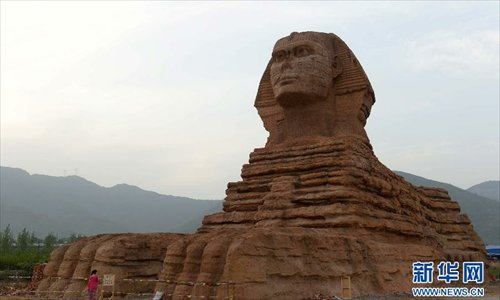China vows to ban notorious copycat architectures
By Huang Lanlan Source:Global Times Published: 2020/5/7 22:22:23

The copycat construction of the Great Sphinx of Giza in Hebei Province (Photo: Xinhua)
China has announced to ban the notorious copycat architectures across the country, which has garnered great appreciation from the public.The government will strictly prohibit plagiarizing, imitating, and copycatting designs of other buildings, according to a notice jointly released by the Ministry of Housing and Urban-Rural Development and National Development and Reform Commission in late April.
Chinese netizens praised this decision with several users saying they've got bored with the fake, shoddy versions of foreign buildings in many third and fourth-tier Chinese cities.
"The ban is great," wrote a Weibo user named kuxiaohaier. "It's much better to protect our historical architectures than build fake copycat ones."
Another user named huanhuahua grumbled about a White House copycat in East China's Jiangsu Province she encountered years ago. "It burned my eyes," she posted.
Annoying copycats of renowned foreign landmarks, such as Arc de Triomphe, Tower Bridge, Sydney Opera House, and the Moscow Kremlin have emerged continuously in China's small cities and towns in recent years, sparking controversies and even legal disputes.
A replica of the Great Sphinx in North China's Hebei Province, for instance, was demolished in 2016 after receiving a complaint from Egyptian authorities in 2014. Worse still, the replica was rebuilt in the same place in 2018 despite the international backlash.
The emergence of copycat architectures in Chinese cities is partly a result of cultural unconfidence, said Han Feng, head of Department of Landscape Architecture under Tongji University.
Lacking confidence in Chinese architectural culture, some local authorities and investors blindly regard foreign buildings as best designs, Han said.
"In fact, China itself has lots of outstanding works in history with its rich architectural culture," Han told the Global Times Thursday, citing some classical Chinese gardens that are listed as UNESCO World Heritage Sites.
"Rather than simply imitating and copying foreign buildings, it is urgent for architects and the public to know about and learn from our own profound architectural art," she added.
Posted in: SOCIETY